
So began Gwentomologist on her Instagram account.
"Beewolves are in the genus Philanthus," she continued. "This species is Philanthus multimaculatus. They are in the family Crabronidae. This species is native to the west coast of the United States. Beewolf wasp adults eat nectar from flowers, but the larvae are carnivores! The females dig out tunnels in the soil for their young. They catch and sting bees, then bring them into the nest. They lay their eggs in this little nest and block it off so it is protected. The wasp larvae feed on the provisions their mother provided for them, and then emerge in the summer as adults, to start the cycle again!"
She added: "I just love their green eyes so pretty! These wasps are important pollinators, just like bees, and they control the bee populations. As bees decline in population size, these wasps also suffer."
Who is Gwentomologist?
She's 21-year-old Gwendolyn “Gwen” Erdosh, a UC Davis entomology major and undergraduate researcher with more than 22,000 followers on Instagram, where she shares her fascination, passion and growing scientific knowledge of entomology with the intensity of a moth heading for light.
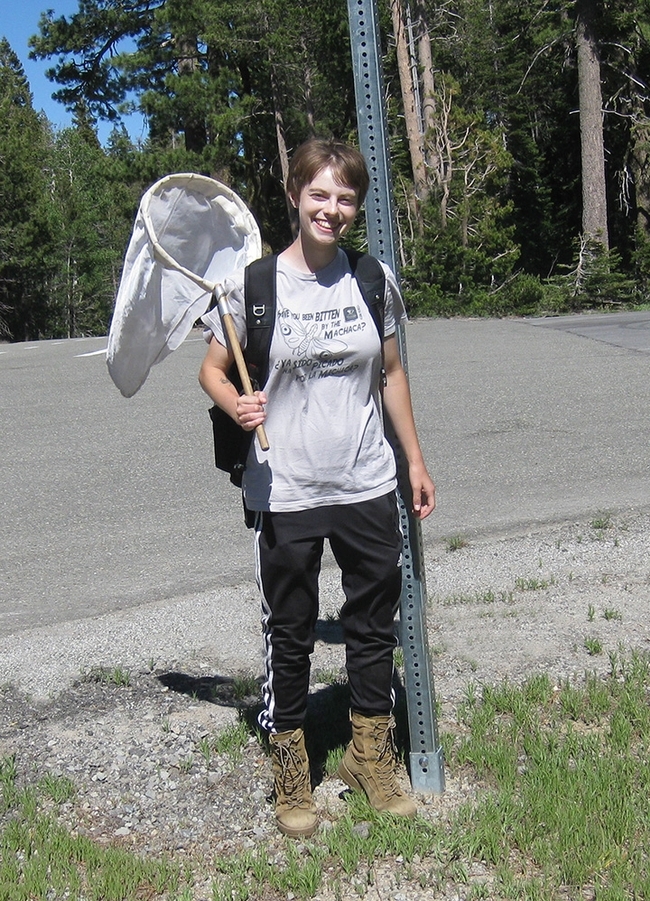
Gwen launched her Instagram account in 2013 to share her passion for moths and butterflies (Lepidoptera). “Back then, it was one of only a few accounts that focused on such a niche interest," she said. "It quickly grew in popularity and a community of insect-obsessed teenager formed, all with similar goals. Through social media, we were able to make amazing connections, which I still have today. Eventually, my passion expanded from just Lepidoptera to a fascination with every type of arthropod on the planet!”
On her account, she posts "my own macro-photographs with detailed captions about the featured insect. My goal is to not only teach others, but also learn a lot myself. I also post fun and engaging videos to encourage others to pursue entomology. Many times, people have told me that my page helped them decide that they wanted to pursue entomology as a career! I love being able to spread the love of insects to others, and will continue to be active on my page.” Additionally, she maintains a YouTube account as “gwentomologist.”
She captures the images with either her Nikon D3200 with a Sigma105 mm f/2.8 EX macro lens, or her Iphone 11.
A 2018 graduate of Los Gatos High School, Santa Clara County, and a UC Davis student since 2019, Gwen anticipates receiving her bachelor's degree in 2023. In February 2020, she applied for—and was accepted—into the highly competitive RSPIB program, which aims to provide undergraduates with closely mentored research experiences in biology. She studies with community ecologist and professor Louie Yang, UC Davis Department of Entomology and Nematology, one of the three RSPIB founders.
“I actually first met Gwen when she was still in high school,” said Professor Yang. “She was doing a research project with monarch butterflies and emailed me with a few questions. Even then, I was impressed with her knowledge, focus and determination, and was glad to hear when she came to UC Davis. She applied to the Research Scholars Program in Insect Biology early on, and was a stand-out student in my ENT 105 Insect Ecology class in 2020. It has been great to have Gwen in our lab, and to see her continuing to develop as a scientist.”
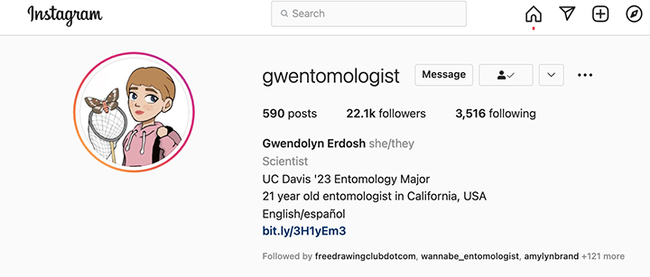
“Ever since I can remember, I have always loved caterpillars,” Gwen said. “As a little kid, I would collect any caterpillar I saw and raise it to adulthood.” Amazed that a caterpillar could "magically change” into a moth or butterfly, she decided “to make a book matching every caterpillar to its adult. I did my own research online and in books I had, and soon was quite knowledgeable about Lepidoptera."
"The summer before 9th grade, I attended Bio Boot camp, the summer camp for kids led by the Bohart Museum, and Tabatha Yang (education and outreach coordinator). “This was the experience that led me to choose entomology as a career. During this camp, I learned everything about entomology and had a chance to meet real entomologists at UC Davis, and do field work. I fell in love with it and kept coming back each summer for the camp.”
Gwen said she is most interested in four insect orders: Hymenoptera, Neuroptera, Coleoptera and Hemiptera. “I also really like Mygalomorphs. I am really fascinated by parasitoids, and hope to do research with parasitoids (wasps, flies, etc.) in the future.”
Following her UC Davis graduation, she plans “to work abroad for a year in South America doing research. I then want to apply for graduate school in the United States. I may decide to get my masters first in systematics, and then decide if I want to get my PhD in insect ecology or insect systematics. I cannot decide between the two. However, I definitely want to pursue a career as a professor and researcher.”
Her pre-UC Davis life includes:
- 2016. As a 15-year-old high school student, Gwen traveled to the Bohart Museum in 2016 for its annual Moth Night and conferred with many of the scientists.
- 2017. At age 16, she served an entomology internship at Cornell University, where her work included identifying microlepidoptra in the family Tortricidae; sampling monarch butterflies for Ophryocystis elektroscirrha (OE) spores; catching and tagging the gray petaltail dragonfly (Petalurid) at a local state park; and collecting, identifying and presenting moths for a Moth Night program at the Roger Tory Peterson Institute of Natural History.
- 2018. At age 17, Gwen gained experience at a five-week internship in the summer of 2018 at the Monteverde Butterfly Gardens in Costa Rica, where she studied insects, conducted tours, and cared for the arthropods in the insectarium.
Although sometimes mistaken for a teenager--“I look young for my age and I'm 5' 1”--Gwen doesn't let that stop her. “I now have accepted who I am and I do not let what others think of me affect me or my goals. I am glad that I am unique!”
"Gwen is one of those students who instantly shows you her enthusiasm and enjoyment of entomology and it is just this kind of person who we hope will continue in this important field of science," said entomologist Jeff Smith, who curates the Bohart Museum's Lepidoptera collection. "For those of us looking ahead at the oncoming 'golden years' we need to ensure that there will be competent young scientists who will continue the research and who will discover so many more fascinating things about the world of ‘bugs.' Gwen clearly will be one of these, and I am proud to be associated with her.”
Attached Images:
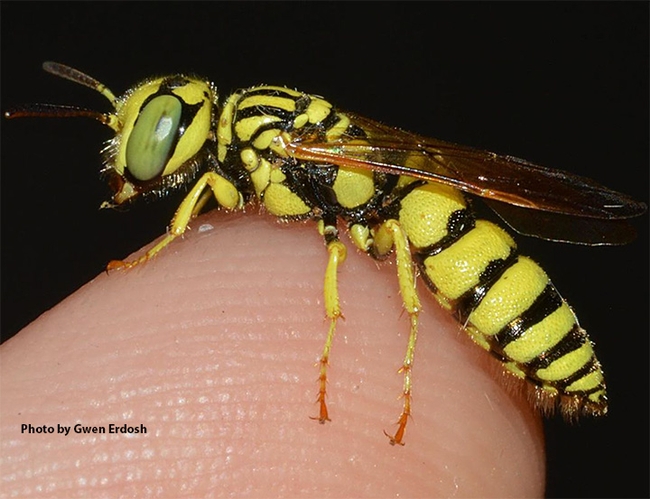
A beewolf photographed by Gwen Erdosh, aka Gwentomologit, and posted on her Instagram account.
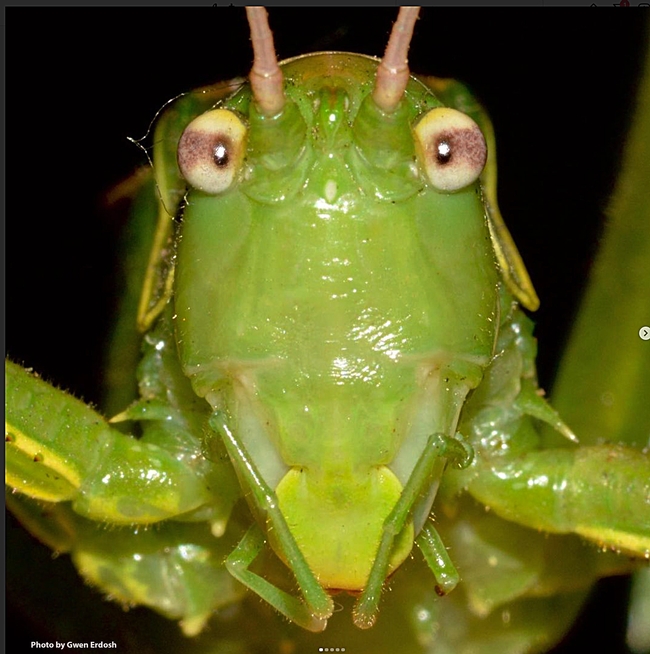
This is a rare grasshopper, a male Chaparral Shieldback, Cyrtophyllicus chlorum, that Gwen Erdosh found and photographed in Winters. She posted this on her Instagram account.
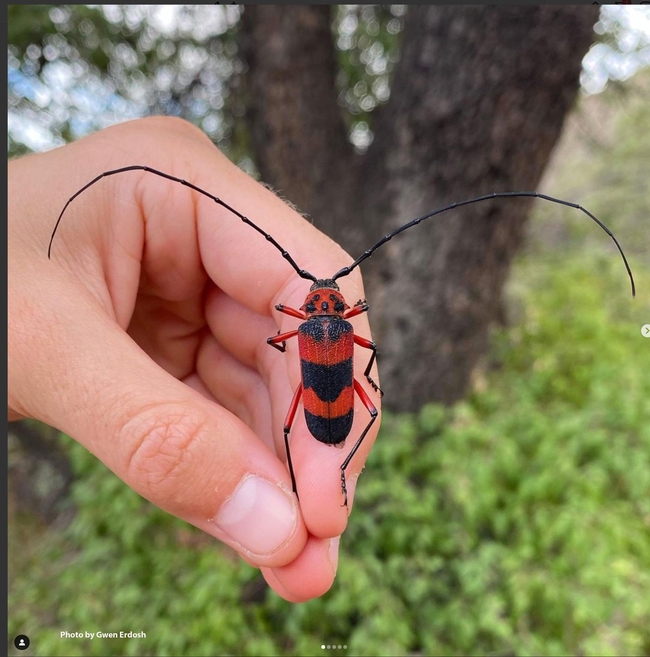
This is a Texas Canyon longhorn beetle, Megapurpuricenus magnificus, that Gwen Erdosh photographed with her Iphone 11 in Tucson, Arizona. "This beetle only appears every three years for about two weeks to reproduce, and it is only found in a few spots in the United States," she wrote on her Instagram account.

"Mantisflies are neither mantises nor flies, they are actually neuropterans, just like lacewings and antlions!" Gwen Erdosh writes on her Instagram account. "They evolved raptorial forelegs separately from mantises, which is called convergent evolution." (Photo by Gwen Erdosh)
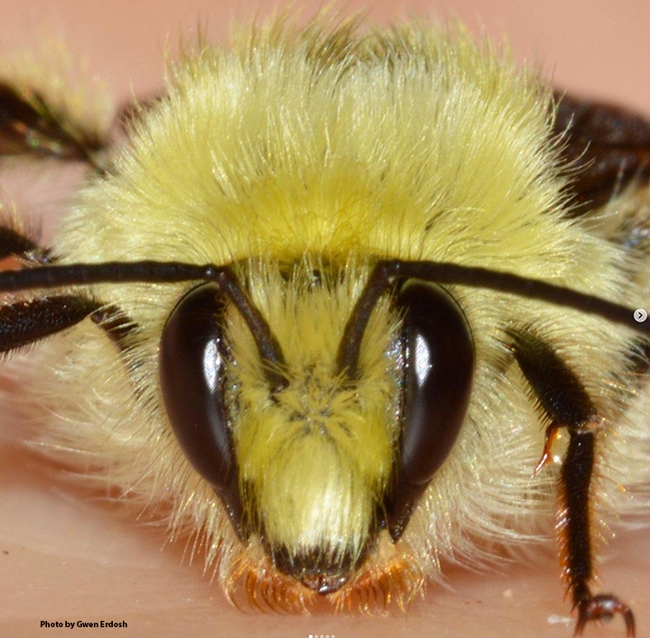
A close-up of a bumble bee, a male Bombus vandykei by Gwen Erdosh. She posted this on her Instagram account.